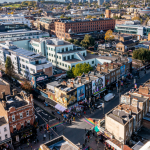Unemployment continued to fall in London, New York, Berlin and even Hong Kong as 2021 came to a close and demand for labour rebounded. Paris data (Q3 2021) suggested a similar trend (data for Q4 has not yet been released).
Black and minority ethnic New Yorkers and young Black Londoners continue to experience a much higher unemployment rate than their White counterparts.
London’s unemployment rate decreased from 5.6% to 5.2%, notwithstanding the end of the furlough scheme in September 2021 and the onset of the Omicron variant.
London no longer has the highest unemployment rate in the United Kingdom, although it is still above the average in England. Given the rising demand for labour in the capital, unless the Ukraine war and post-Brexit labour and skills shortages curtail recovery, unemployment could reduce further still. If the current trend continues in early 2022, London’s unemployment rate could be set to return to its pre-pandemic level of 4.8%.
The unemployment gap between White and Black, Asian and Minority Ethnic groups (BAME) has widened during the pandemic, and UK data shows it is not closing: in Q3 2021, the unemployment rate for people from a Black or Minority Ethnic background was more than twice the rate for White people.[1] This was especially the case for young people: data from November last year showed that Black Londoners (16-24) were twice as likely to be unemployed as White Londoners of the same age.[2] The gap in unemployment between Black or Minority Ethnic and White Londoners over the age of 16 had been slowly closing from the mid-2010s but this was reversed by the pandemic – as Black and Minority Ethnic groups saw a much larger rise in unemployment than White people nationally.[3]
New York City has seen a considerable decline in unemployment to just over 8% after having suffered highs of more than 18% at the peak of the pandemic in mid-2020. Despite this, it still has a much higher unemployment rate than in 2019, which shows the lasting effect of job losses during the pandemic, as US schemes to protect employment have arguably proved less effective than schemes in the UK, France or Germany. This is partly because the US Paycheck Protection Program was only available on a first-come-first-served basis with a cap in total spending. This meant not all businesses could benefit. It was focused on small and medium size businesses, with an upper limit on support to each business. Support terminated in May 2021.[4]
As in London, the New York’s unemployment rate for minority ethnic groups was higher than for White groups; unemployment for Black non-Hispanic people has risen over 2021 to 15.2% in Q4, whilst rates for White non-Hispanic groups rates were at 6.3%.[5] Some of these disparities predate the pandemic – across New York State, 2019-2020 saw unemployment rates for both Black and White groups increase by 5.4 percentage points, but for Hispanic groups, unemployment increased by 9.4 points.[6]
Paris-Île de France and Berlin continue to see higher unemployment rates compared to London but lower than that for New York. Both cities’ labour markets have been relatively sheltered from the impact of the pandemic thanks to government furlough schemes, which unlike the UK’s, existed before the pandemic (and were not covid-related when they were introduced). As such these schemes have not been wound down. Berlin’s unemployment rate has only increased by 1 percentage point between Q1 2020 and Q4 2021, but it entered 2020 with the highest rate of any of our surveyed cities. As far as we are aware, France and Germany do not collect statistics on ethnicity and unemployment.
With its tightly sealed labour market, Hong Kong remains the city with the lowest unemployment rate and has remarkably outperformed its pre-crisis figures. A state-funded voucher scheme to stimulate domestic consumption appears to have reduced the unemployment rate in sectors related to consumption, though strict social distancing rules and the closure of enterprises such as gyms and bars are likely to have put downward pressure on job growth.[7] Falling job-posting numbers in the territory suggest that unemployment may start to rise at some point.
[1] House of Commons Library (25 February 2022). Unemployment by ethnic background. Retrieved from: https://commonslibrary.parliament.uk/research-briefings/sn06385/
[2] Cohen D. (30 November 2021). Young black Londoners twice as likely to be unemployed as white counterparts. The Independent. Retrieved from: https://www.independent.co.uk/news/uk/home-news/black-unemployment-young-people-london-b1966612.html
[3] House of Commons Library (25 February 2022). Unemployment by ethnic background. Retrieved from: https://commonslibrary.parliament.uk/research-briefings/sn06385/
[4] Small Business Administration. PPP. Retrieved from; https://www.sba.gov/funding-programs/loans/covid-19-relief-options/paycheck-protection-program/ppp-loan-forgiveness#section-header-2 and Institute for Government. (10 January 2022). Coronavirus: how different countries supported the unemployed. Retrieved from: https://www.instituteforgovernment.org.uk/explainers/coronavirus-unemployment-support
[5] Parrott, J. (27 January 2022). New York City’s pandemic jobs deficit stood at 421,000 in December 2021; 15.2 percent Black unemployment in the fourth quarter. Center for New York City Affairs. Retrieved from: http://www.centernyc.org/reports-briefs/new-york-citys-pandemic-jobs-deficit-stood-at-421000-in-december-2021
[6] Department of Labour NY State. (January 2022). Current Population Survey Data New York State: 1970-2021. Retrieved from: https://dol.ny.gov/system/files/documents/2022/01/cps-1970-2021_0.pdf
[7] Magramo K. (18 January 2022). Coronavirus: latest Hong Kong unemployment rate drops to 3.9%, but labour chief warns extended social-distancing curbs could lead to joblessness rising again. South China Morning Post. Retrieved from: https://www.scmp.com/news/hong-kong/hong-kong-economy/article/3163848/coronavirus-latest-hong-kong-unemployment-rate


